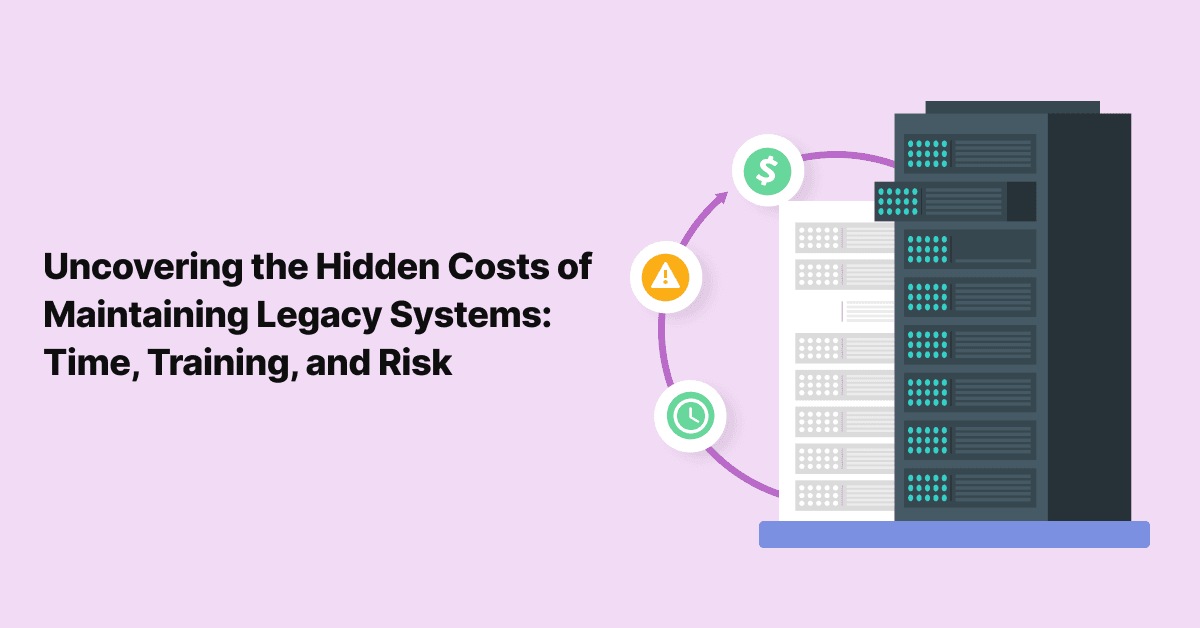
Healthcare Data Archival Strategy
Every year huge amounts of data are created by healthcare organizations in the form of lab results, patient …

Operating legacy systems can be a costly endeavor. Maintaining and upkeeping legacy systems require a vast amount of resources in terms of time, personnel training, and strategic risk management to keep them secure against the ever-evolving threat landscape. Gaining insight into these additional costs associated with maintaining older platforms can provide your organization with the clarity needed to develop an effective modernization strategy that will save you from hidden financial losses related to your legacy investments.
Through this blog, you will be able to explore the hidden costs associated with using and maintaining legacy systems and what are the solutions that could help in mitigating those.
Explore:
Legacy systems are outdated software or hardware that is still being used by an organization. With the rapid pace of technological advancements, it is not uncommon for businesses to retire their systems every few years in favor of newer and more efficient technology.
However, there are plenty of reasons why companies still rely on these dated systems. For one, migrating to newer tech can be expensive and time-consuming. Additionally, legacy systems can hold valuable data and processes that might not be replicable on newer systems.
Therefore, maintaining these systems is crucial to ensuring that businesses continue to function smoothly and effectively. Failure to do so can result in lost productivity, revenue, and ultimately, customer satisfaction. By preserving legacy systems and integrating them with newer tech where possible, organizations can make the most of their operational investments while embracing the future.
The maintenance of legacy systems in healthcare can be a costly and time-consuming process. One of the biggest challenges of maintaining legacy systems in healthcare is the time and cost associated with it. Legacy systems are often complex and require specialized knowledge and expertise to maintain. This means that healthcare organizations must allocate significant resources to keep these systems running, which can divert time and resources from other critical projects and initiatives.
The time required to maintain legacy systems can impact the efficiency and productivity of healthcare professionals. For example, healthcare providers may need to spend more time navigating through complex user interfaces or dealing with system errors and crashes. This can lead to a significant loss of time and productivity, as well as increased frustration and burnout among healthcare professionals.
Moreover, the duration of maintaining legacy systems can also result in increased costs. As legacy systems become more outdated, they may require specialized knowledge and expertise to maintain, which can be costly. Healthcare organizations may need to hire specialized personnel to maintain these systems or provide extensive training to existing staff. Additionally, as vendors discontinue support for legacy systems, healthcare organizations may need to invest in costly customizations or develop workarounds to keep the systems running.
Another hidden cost of maintaining legacy systems is training.
The need for ongoing training can also result in reduced efficiency and productivity among healthcare professionals. As healthcare organizations invest time and resources in training new staff on legacy systems, healthcare professionals may need to spend more time learning and adapting to these systems, which can reduce the amount of time they have available to focus on patient care and other critical tasks.
Furthermore, the need for ongoing training can also contribute to higher turnover rates among healthcare professionals. As healthcare professionals become frustrated with the inefficiencies and complexities of legacy systems, they may be more likely to leave for organizations that use newer, more modern technology solutions. This can result in increased costs associated with recruitment, onboarding, and training of new staff.
Maintaining legacy systems can also pose a risk to business continuity.
As legacy systems become more outdated, they may become more susceptible to hardware failures, software crashes, and other technical issues that can disrupt the business operations. If these issues occur, one might experience significant downtime, resulting in lost productivity, revenue, and potential damage to organizational reputation.
Furthermore, maintaining legacy systems can also result in a lack of interoperability with newer technology solutions. As healthcare organizations adopt newer technology solutions to improve patient care and business operations, legacy systems may struggle to integrate with these solutions, resulting in data silos and reduced efficiency. This can result in increased costs associated with manual data entry, duplicative work, and decreased accuracy of patient information.
Healthcare organizations must consider these hidden costs associated with maintaining legacy systems and evaluate their options for upgrading to newer, more modern technology solutions. By investing in newer technologies, healthcare organizations can improve efficiency, productivity, and patient outcomes, while also reducing the long-term costs associated with legacy systems. It’s important for organizations to weigh up their options and make sure they have a robust plan in place when navigating their digital transformation journeys. Ultimately, it pays off to invest responsibly in newer technologies that offer advanced capabilities while ensuring that existing networks remain secure and reliable.
Join over 3,200 subscribers and keep up-to-date with the latest innovations & best practices in Healthcare IT.

Every year huge amounts of data are created by healthcare organizations in the form of lab results, patient …

Initiating a healthcare data archival project requires thorough planning and the strategic formation of a …

Information blocking was brought into action to ensure the patient’s right to access their health data was …